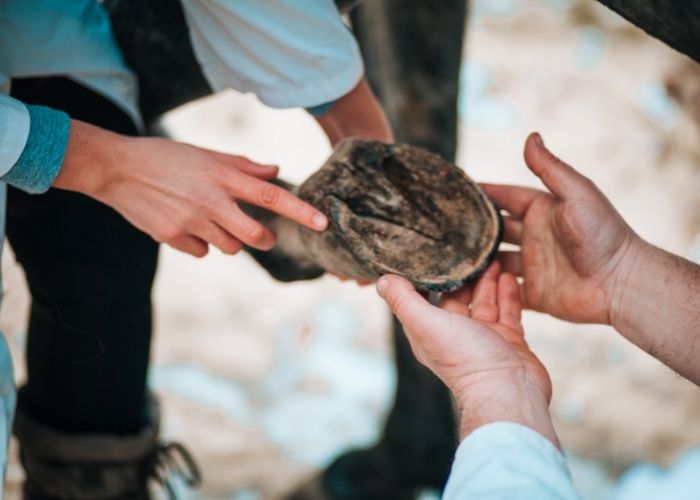Many health problems can impede a horse from competing in shows, so seeking answers to questions like can a horse with navicular jump is understandable. Knowing what health risks a horse may face and how it will affect it, falls under basic care requirements.
Potential health issues can arise and cause problems, which is why it’s important to be prepared. Simply mentioning navicular syndrome may cause fear, both for the horse’s health and the medical bill it promises. Understanding what this health problem entails is the first step to take in caring for the horse.
What Is Navicular Syndrome?
Navicular syndrome, also known as navicular disease, or caudal pain syndrome, affects the structure of the horse’s heel. It is a condition first confirmed in 1752, and it has been a most alarming health condition ever since. The name of the health condition is based on the navicular bone found in the back part of the heel.
The bone itself is not pathologically involved with the disease, but it will still negatively impacts the ability to walk. The potential for affecting the navicular bones, however, is still there, so it must not be entirely excluded.
Signs And Symptoms Of Navicular Syndrome
Looking after a horse will involve knowing how certain health problems impact them, so how does navicular affect a horse? Lameness is the most apparent symptom of navicular syndrome. The severity of this lameness can vary, and in some cases, it can be hard to notice. Less severe cases of lameness can become graver if left untreated.
Pain may occur, and the horse will either hold their foot pointed or slightly raised, putting less weight on it. A horse affected by the navicular disease will display a shorter stride and have difficulty turning sharply. More rugged terrain, hard ground, or going down the hill will also pose a greater challenge.
Causes Of Navicular Syndrome
Before wondering can a horse with a navicular jump, knowing what causes the health problem may help combat it. There isn’t a definite cause for the navicular syndrome, but there are some factors that can contribute to the disease.
A bigger horse that has smaller hooves could have a negative impact on the heels. There is also the question of can a farrier cause a navicular? It has been seen that poor farrier care may lead to the navicular syndrome.
The risk of this disease is present with any horse, but research has shown thoroughbreds are more predisposed to it. In more extreme cases, there will be no question of can you lunge a horse with navicular syndrome, as they will have difficulty walking.
Navicular Syndrome Treatment
Since it’s not exactly possible to know why navicular syndrome occurs, veterinary professionals will make use of a number of tests. Determining this diagnosis is thus a little more difficult and takes a while to implement all the tests. Pondering the question, can a horse with a navicular jump, takes a back seat in favor or how to treat it.
Treatment for navicular syndrome involves mainly managing the disease. Sometimes owners ask do horses with navicular need shoes? When it comes to horseshoes, redoing the old ones could help in relieving some of the pain.
Egg and bar shoes are often time used by farriers to help with protecting the frog when dealing with navicular. Anti-inflammatory medication may be prescribed for the pain, either oral medication or hoof injection. High rates of success have been reported with combining medication and specific shoeing geared at therapeutically strengthening the shoe.
More drastic measures are sometimes taken when medication and reshoeing fail. A portion of the nerve is surgically extracted from the back of the pastern. While this technique provides short-term pain relief, in the long run, it will only aggravate the disease resulting in a life-threatening rupture.
Additional Details On Navicular Syndrome
Many show riders ask can a horse with a navicular jump as this is the main focus of competitions. Depending on how acute the disease has become, a vet’s ok would be needed to ride the horse. Jumping with the navicular disease is not encouraged, as it can aggravate symptoms.
Recovery is always a main point of interest for owners that have to deal with this health problem. Unfortunately, there is no cure for the navicular syndrome, and the best option is to treat symptoms and provide comfort.
Ordinarily, this disease would bring a horse’s carrier to an end; however, recent medical evolutions have improved treatments. This meant that many horses were still able to work with navicular syndrome using pain management medications and treatments.
Final Thoughts – Can A Horse With Navicular Jump
Caring for a horse, in general, is certainly not a simple task, but having to treat navicular syndrome is harder. This disease is a very serious one, and at present, there is no way of curing it completely. As such, riders that compete will surely want an answer to the question: can a horse with a navicular jump?
The only thing one can do is treat the symptoms and alleviate the pain. With a vet’s approval, a horse with this condition may be well enough to be ridden, but possibly not enough to perform elaborate jumps.
Read more about What Is An Oxer Jump?
Can you lunge a horse with navicular?
Depending on the seriousness of the disease, a horse may have more or less difficulty walking. Lunging might be possible in earlier stages with less pain and medication that can stifle it. Lunging might be an efficient way to provide the horse with the exercise needed without having to ride the horse.
How does navicular affect a horse?
Navicular syndrome is a troublesome condition to deal with and it oftentimes manifests with limping, lameness and pain. In a majority of cases, navicular is a carrier-ending disease, and it can only be managed but not cured.
Can a farrier cause navicular?
Improper farrier care may possibly lead to navicular syndrome. There is no specific cause for navicular syndrome so it would be guesswork to place blame solely on poor farrier care. Many other factors can contribute to the condition.
Do horses with navicular need shoes?
It is necessary to employ a farrier to treat the condition, with reshoeing and even therapeutic shoeing with bar or eggs shoes. These shoes protect the frog and help offer some support when navicular syndrome occurs.

